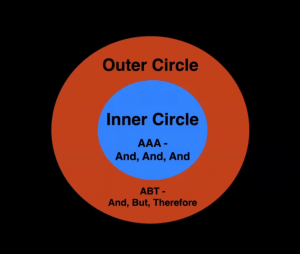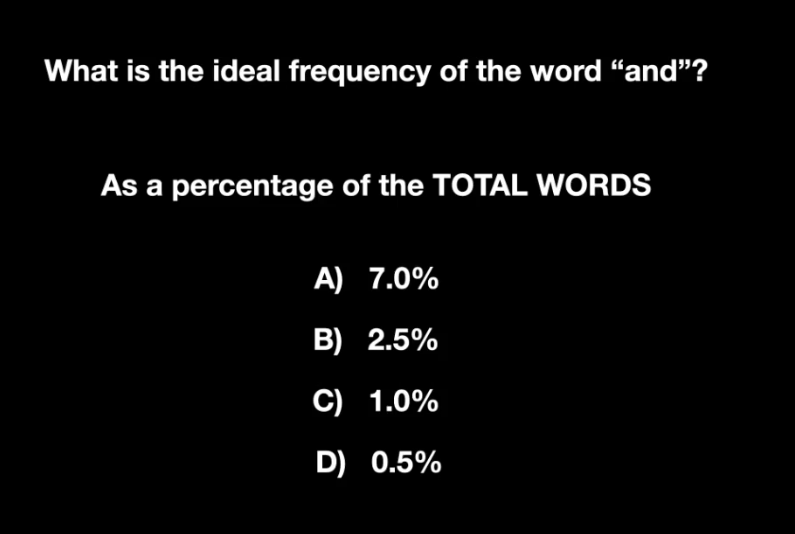ABT Framework Student Resource Page Round 23
Contents
Session 2 Resources – Outer Circle
Session 3 Resources – Hero’s Journey
Session 4 Resources – Narrative Analysis
Session 5 Resources – Classical Design
Session 6 Resources – Narrative is Leadership
Session 7 Resources – Listening with Brian Palermo
Session 8 Resources – Business with Park Howell
Session 9 Resources – Law with Doug Passon
Session 10 Resources – Synthesis
Social Media – Keep up with us on the web
Mondays: 11:00 am PST to 12:00 pm PST
Wednesdays: 11:00 am PST to 1:00 pm PST
February: 7, 9, 14, 16, 23, 28
March: 2, 7, 9, 14
Download the ABT Blue Card – Have it open or printed out and ready for each class.
Watch the AAAS video:
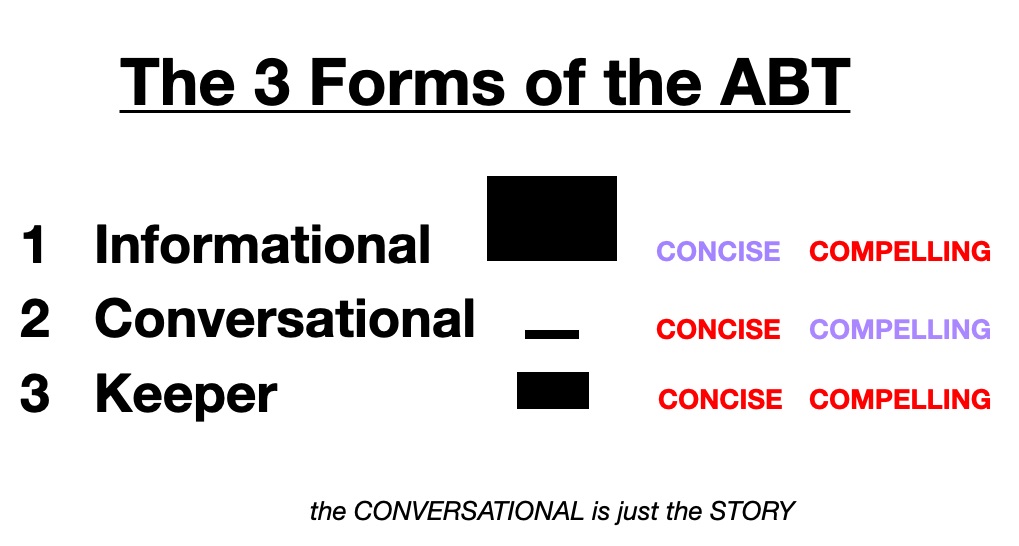
Medical Obfuscation: Structure and Function – Michael Crichton’s paper on how medical communication does NOT have to be as complicated as it is.
Three Forms of the ABT – It’s recommended you read this excerpt from Houston, We Have a Narrative and get an understanding of the cABT (Conversational ABT).
ABT Blue Card – The 3 step model for the class that you can use as a guideline for building and improving your ABT.
Optional Exercise #1: The 5 Word Problem
“What’s the problem?” is the most common question Randy asks during the ABT Builds. For this exercise, try to finish this sentence “The problem is _____” and use only 5 additional words.
Examples: The problem is bad resource management.
The problem is the old method doesn’t work.
The problem is we have bad data.
Stripping down your problem to just 5 words can help you clarify what your narrative is actually all about and focus in on the real problem that you want to address.
Session 2 Resources – Outer Circle
The One Thing:
Nicholas Kristof’s Advice for Saving the World – The importance of the singular narrative. Once you increase the size of a narrative from one person in need to two people in need, compassion drops in the audience.
Compassion Fade: Affect and Charity Are Greatest for a Single Child in Need – The research article that “Advice for Saving the World” references.
Uri Hasson’s Paper on Neurocinematics – For a look at how narrative and non-narrative effects the brain. This paper was referenced in the AAAS video.
Is the scientific paper a fraud? – The real world is “and, and, and,” but the scientific paper is crafted into the IMRAD template to create a narrative.
‘Data-Driven’ Campaigns Are Killing the Democratic Party – The article in which Dave Gold coined the term “Christmas Tree” when looking for an overarching problem. It’s okay to have several problems in your narrative, but you need to find the overarching Christmas Tree problem for your narrative that all the other problems can hang off of like ornaments.
Optional Exercise #2 –“This is a story of…” – Processes – Ultimate & Proximate
This is another exercise that would be handy to have done before your in class ABT Build with Randy because Randy asks this question for roughly 99% of ABT Builds.
For this exercise, tell us what your ABT is about by finishing this sentence and using only 3 additional words “This is a story of____.”
It seems simple, but this exercise is tricky because participants tend to focus on the subject. But stories need more than a subject, they need action. Processes are where you find that action. Common processes for ABTs could include adapting, managing, protecting, restoring, strategizing, educating.
Examples:
- Protecting a species
- Strategizing building restoration
- Managing conservation efforts
- Restoring wildlife
- Adapting to change
- Educating our stakeholders
Look at this example ABT:
Congressional funding is a key requirement for the continuation of important aviation research, and we know that our research allows us to be better able to manage our wildlife habitats and protect endangered species. But program managers don’t feel confident about securing future funding because some research areas are not receiving enough attention. Therefore, we need to effectively promote the proven success in these research areas to secure future funding.
When asked to complete the sentence “This is a story of____,” a possibility is “This is a story of aviation research.” But this is just the subject and it doesn’t tell us what action is taking place in this story.
Instead of the subject (aviation research), focus on the process. If you wanted the process for the broader story, the Ultimate Goal, then the process might be “secure,” since ultimately the purpose is to secure the future funds. “This is a story of securing future funding.”
“Securing future funding” is the Ultimate Goal, but you can take it down to a narrower level by focusing on the specific process, the Proximate Goal, you want to go through to get that future funding: “This is a story of promoting our successes.”
Ultimate Goal: Securing future funding.
Proximate Goal: Promoting our successes.
Fulfilling the Proximate Goal will lead us to succeeding at the Ultimate Goal.
Try to fill in “This is a story of____” for your ABT using only 3 additional words (focusing on the process) or less. Do one version for the Ultimate Goal and one version for the Proximate Goal.
Session 3 Resources – Hero’s Journey
Matthew Winkler Video: What makes a hero? – We only watched the first two minutes in class. Watch this to the end to see how the hero’s journey applies to your life:
Bankspeak: The Language of World Bank Reports, 1946–2012 – The Literary Lab report on how the World Bank reports are completely unreadable, due in no small part to the overuse of the word “and” to glue together contradicting statements.
A spat over language erupts at the World Bank – The somewhat dismissive economist article on the “conjunction dysfunction” about the Literary Lab’s report.
Optional Exercise #3: Using the Dobzhansky Template to find your “One Thing.”
Restructure your ABT in the form of a Dobzhansky Template to help you find your singular narrative.
Dobzhansky Template: Nothing in _______ makes sense, except in the light of ________.
Examples: Nothing in biology makes sense, except in the light of evolution.
Nothing in geology makes sense, except in the light of plate tectonics.
Nothing in the management of mule deer makes sense except in the light of correctly estimating abundance.
Nothing in the challenge of teaching human anatomy makes sense except in the light of time management.
Session 4 Resources – Narrative Analysis
Answer: 2.5%.
You can try a basic narrative analysis on your own writing. Find the total word count for your document. Then do a word search for the word and (put a space on either side of and for your search). Take the number of ands and divide them by the total word count to get your AF (And Frequency). If you get around 2.5% for the result, you’re doing great!
Oprah’s Golden Globes Speech – A great example of using Nested ABTs. Color coded in the ABT format.
Optional Exercise #4: Using the Dobzhansky Template to find your “One Thing.”
Restructure your ABT in the form of a Dobzhansky Template to help you find your singular narrative.
Dobzhansky Template: Nothing in _______ makes sense, except in the light of ________.
Examples: Nothing in biology makes sense, except in the light of evolution.
Nothing in geology makes sense, except in the light of plate tectonics.
Nothing in the management of mule deer makes sense except in the light of correctly estimating abundance.
Nothing in the challenge of teaching human anatomy makes sense except in the light of time management
Session 5 Resources – Classical Design
Classical Design:
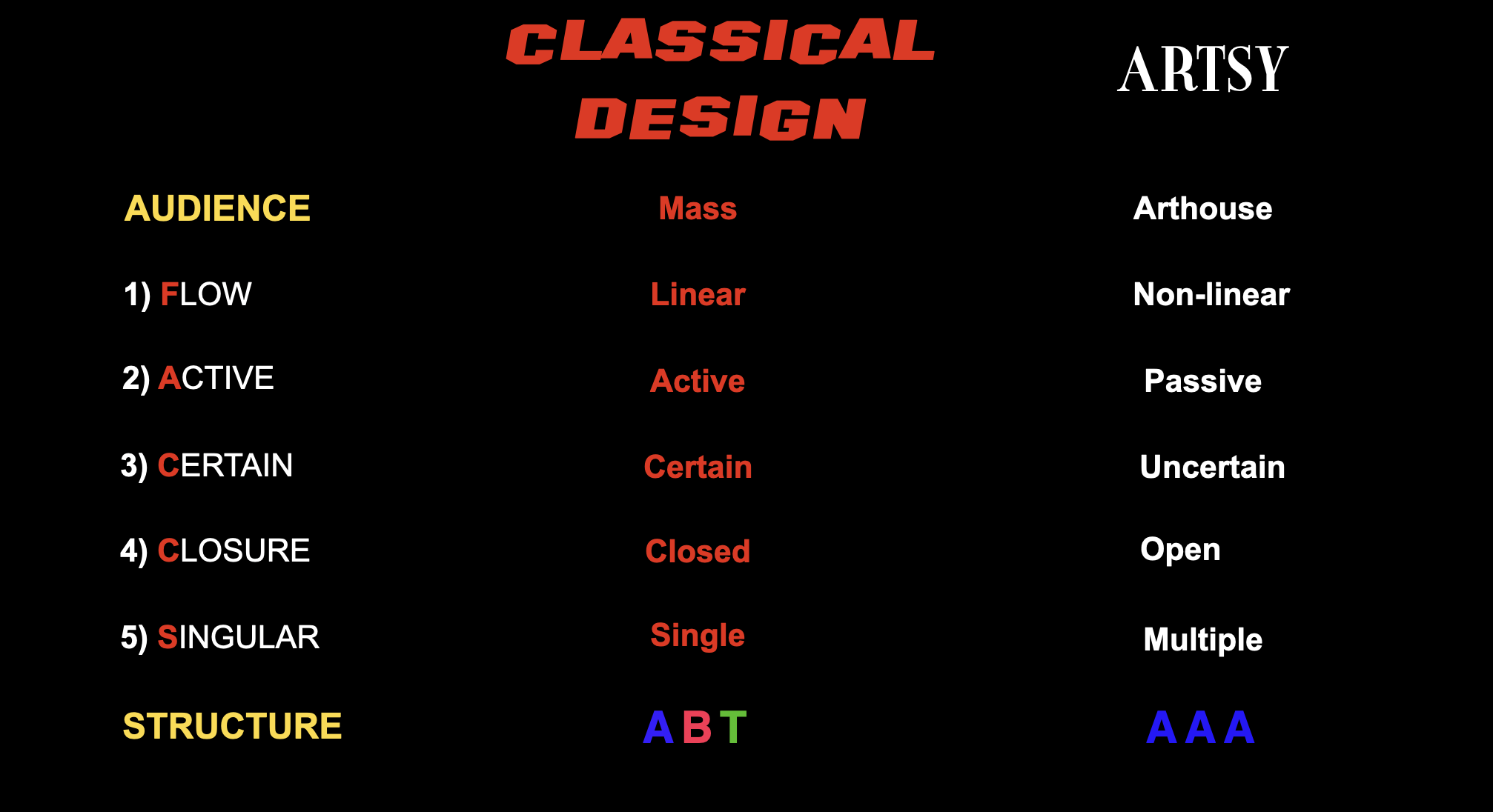
Randy’s recent presentation for Scripps on the failure of Covid communication:
Story by Robert McKee – For those of you who want to do a deep dive into the history and structure of story, this is the book for you.
Don’t Be Such a Scientist, Second Edition: Talking Substance in an Age of Style – Randy’s book on all the things that hold scientists back from being good communicators.
Optional Exercise #5: Past, Present, & Future
There’s a few different variations of the kABT. We’ll be looking at one of them here, the Past-Present-Future ABT.
The Past-Present-Future format isn’t applicable to all topics, but we can experiment and see if it is with yours. For your project, craft the AND in a way to tell the audience what was going on before in your project or your old method for addressing a problem. For the BUT, tell the audience the current problem with the old method of doing things. For the THEREFORE, let us know the solution that you’ll be attempting to implement in the future.
The cABT for a Past-Present-Future ABT might look like: “We were doing this one method for the longest time AND it worked well enough, BUT a new issue came up, THEREFORE now we have to fix it by doing a new thing.”
You could also attempt an IF/THEN in a Past-Present-Future ABT, for example: “We were doing this one method for the longest time AND it worked well enough, BUT a new issue came up and IF we don’t fix it THEN it’s going to get really bad, THEREFORE now we have to fix it by doing a new thing.”
Try filling in the details with your own project and make your own kABT using the Past-Present-Future ABT format.
Or fill in the details with facts about your life to make a Past-Present-Future ABT for introducing yourself at parties or networking events: “I was doing this one thing, BUT then a big issue came up, THEREFORE now I’m focusing on this other thing.”
And you can break out the Past-Present-Future ABT if you’re ever put on the spot by your employer with a question on where you’re at with a project at work. cABT: “Well boss, we got all this stuff done and it’s working great, but now we’ve got a new problem, so we’ll be doing a bunch of steps to fix it.” Fill in the details to that cABT on the fly and your boss should be up to speed on what you’re up to.
Session 6 Resources – Narrative is Leadership
The Steve Jobs (ABT Brain) and Bill Gates (AAA Brain) interview. Skip to 7:11 for the section that Randy showed in class.
AND Frequency and Narrative Index score ratings:

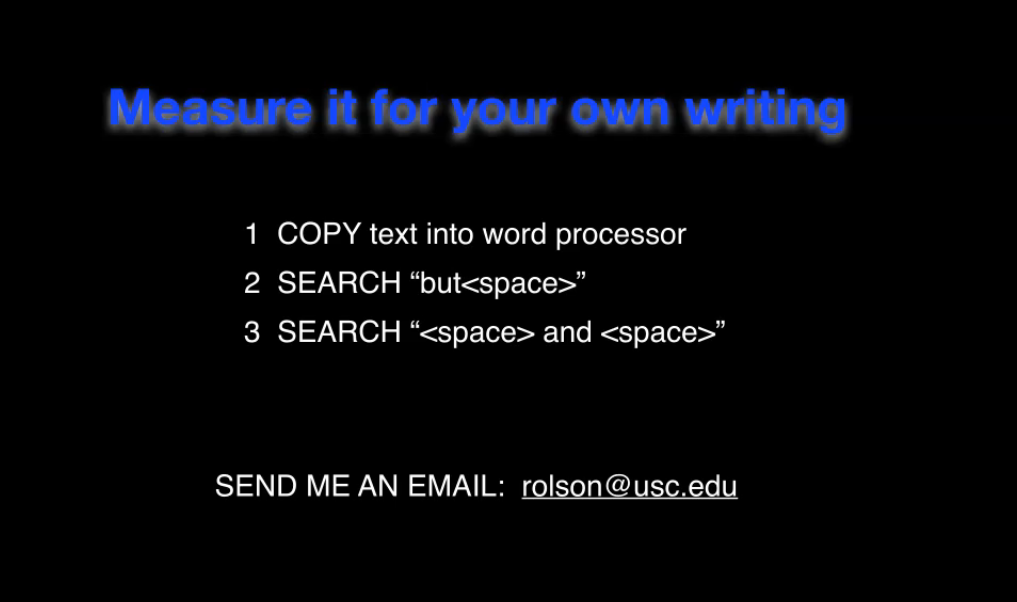
Optional Exercise #6: Expected Vs Observed – Leading us to the ideal world
Time to look at a different version of the kABT, the Expected Vs Observed ABT.
The Expected Vs Observed ABT isn’t applicable to all topics, but we can experiment and see if it is with yours. For your project, paint a perfect world in the AND in which everything goes right, what you would Expect from your “ideal world.” Aim for Heaven!
Unlike the Past-Present-Future ABT, this time you’re starting the AND out in the ideal, perfect future, not the past. A positive IF/THEN in the AND is often helpful here in really driving home what the stakes are if all goes according to plan.
Then for the BUT, tell us the problem that you’re Observing which is interfering with this perfect world you envisioned in the AND. Aim for Hell!
Finally, for the THEREFORE, tell us how you’ll lead us out of the problem of the BUT and back to the ideal world of the AND.
A typical Expected Vs Observed cABT: “We’ve got this great project AND IF everything goes to plan THEN we’ll get all kinds of great benefits BUT right now it’s not working because of a problem THEREFORE we need to fix it by doing some stuff.”
Try filling in the details with your own project and make your own kABT using the Expected Vs Observed ABT format.
Session 7 Resources – Listening with Brian Palermo
Audience focused communication requires listening:
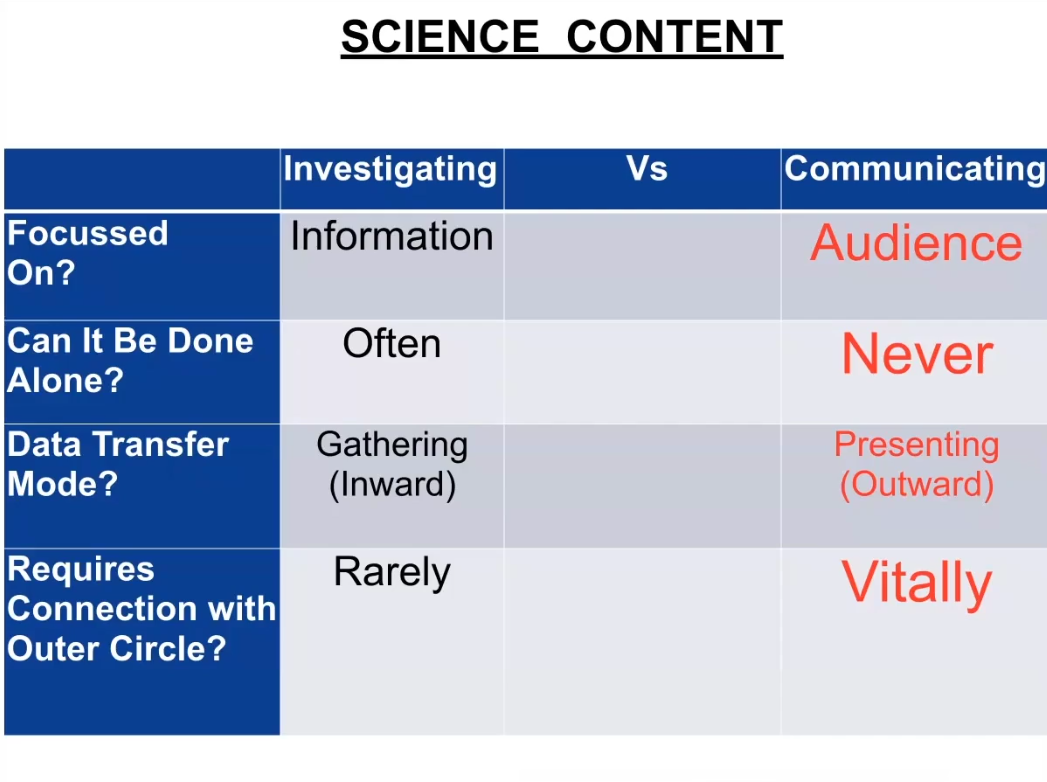
Brian Palermo’s Resources – Brian offers a number of resource videos on his website, some with interactive exercises built in. Topics include listening, utilizing emotional intelligence, and audience focused communication. He also offers online improv training to help improve listening and communication skills.
Don’t Be Such a Scientist, Second Edition: Talking Substance in an Age of Style – In this second edition of Randy’s book, Randy added a brand new chapter: “Don’t Be Such a Poor Listener.”
Rather Than Arming Our Differences, We Need To Embrace Them—and Simply Be NICE – An article on how shared values and first principles can help us bridge divides between different groups. And for the purposes of our course, where do you bridge that divide? The blue section.
Optional Exercise #7: Headline statements – BUT/BECAUSE & THEREFORE/BY
Step 3 of the ABT Blue card talks about the WHAT and the HOW for your problem in the BUT, but what does that mean exactly?
Let’s look at this example ABT:
Our storage facility cares for over 200,000 sensitive computer parts that are vital to our company’s sales, BUT poor storage conditions with inadequate temperature, moisture and insect control are allowing deterioration of this hardware, THEREFORE we need to fund construction of a new building to halt degradation before our inventory is lost.
In the BUT for this problem we have a WHAT and a HOW.
WHAT is the problem: deterioration of this hardware
HOW is it happening: poor storage conditions with inadequate temperature, moisture and insect control.
Notice in the ABT that the HOW comes first. This is a common problem with Inner Circle people (especially scientists) who try to “build their case” first and then arrive at the conclusion (the WHAT) at the end. That works for communication with the Inner Circle, but Outer Circle people will have a hard time following you because they don’t know where you’re going with a chain of logic. They need to get a frame of reference at the beginning – for much the same reason that newspaper articles have headlines.
Think of the WHAT, “deterioration of this hardware,” as the Headline Statement, the big statement of the problem that’s meant to get the audience’s attention.
To check and see if you have your Headline Statement in the correct place, try structuring your RED material as: BUT (Headline Statement) BECAUSE (give details).
BUT our hardware is deteriorating BECAUSE of poor storage conditions with inadequate temperature, moisture and insect control.
You can do the same thing in the the green material with THEREFORE (Headline Statement) BY (give details).
THEREFORE we need to halt the degradation BY funding construction of a new building.
Putting your Headline statement first is very important for helping your Outer Circle follow along with what you’re saying.
For this exercise, look at your own ABT and see if your Headline is in the correct place at the beginning of the BUT and THEREFORE. If it isn’t, try putting it in the beginning and see if it helps.
Session 8 Resources – Business with Park Howell
Park Howell’s Business of Storytelling Podcast – Randy has been featured on a number of Park’s podcasts. Here’s the most recent episode with Randy.
Brand Bewitchery: How to Wield the Story Cycle System to Craft Spellbinding Stories for Your Brand – Park Howell’s book on using the ABT and the Hero’s Journey to help market your brand.
The Narrative Gym for Business: Introducing the ABT Framework for Business Communication and Messaging – The business version of the Narrative Gym, written by Park and Randy.
Optional Exercise #8: Audience as Hero
Time to look at a different version of the kABT, the Audience as Hero ABT.
The Audience as Hero ABT isn’t applicable to all topics, but we can experiment and see if it is with yours. In this ABT format, the audience is the hero of their own hero’s journey, and you (or your organization, process, project, product, etc.) act as the sage/mentor character that guides the audience through the special world to the solution.
Audience as Hero ABTs work best when you have a specific course of action that you want the audience to take, such as to buy a product, fund a research proposal, vote for a ballot measure, support a conservation movement, etc.
For the AND, start with the ordinary world of what you and the audience can agree on as important, properly setting the stakes for something the audience cares about. (Remember the class on Listening? This is where listening to and knowing your audience comes into play.)
For the BUT, tell us the problem that is putting the audience’s important thing at risk.
For the THEREFORE, you (or your organization, process, project, product, etc.) are introduced as the sage/mentor that guides the audience toward the solution to their problems. Remember, you are not the hero of this ABT, the audience is. You are just the guide.
A typical Audience as Hero cABT: “You know that this thing is important to you for some reasons AND IF you have this thing THEN stuff turns out great, BUT this thing is having a problem, THEREFORE we have the solution you can use to fix this problem.”
Try filling in the details with your own project and make your own kABT using the Audience as Hero ABT format.
Session 9 Resources – Law with Doug Passon
Hegelian dialectic – The 3 forces of narrative, Agreement, Contradiction, and Consequence, aren’t a new idea. You can find the roots back in the 1600s with Thesis, Antithesis, and Synthesis.
The Narrative Gym for Law – Doug and Randy’s Law version of the Narrative Gym book.
Optional Exercise #9 : IF/THEN – The tool of HOPE and FEAR
The IF/THEN tool is incredibly powerful at helping to set the stakes and getting very specific. You can use it in the Blue section and it can be a tool for Hope, showing what Heaven could look like it all goes according to plan. Or you can use it for Fear in the Red section, showing how bad Hell can be if everything falls apart.
But what should your IF/THEN be about? To answer that, go back to the optional exercise “This is a story of…” – Processes – Ultimate & Proximate ‘‘ and find your Ultimate and Proximate goals.
Let’s look at the example we used.
Congressional funding is a key requirement for the continuation of important aviation research, and we know that our research allows us to be better able to manage our wildlife habitats and protect endangered species. But program managers don’t feel confident about securing future funding because some research areas are not receiving enough attention. Therefore, we need to effectively promote the proven success in these research areas to secure future funding.
For the example ABT, the goals where:
Ultimate: A story of securing future funding
Proximate: A story of promoting our success.
Now that you have the goals, try crafting them into IF/THEN statements, both positive and negative, and see if you find any variation that has some power. If it helps, you can put them into the form of questions like the ones below for you to answer:
- If you can secure future funding, then what happens? (Hope)
- If you do a good job at promoting our successes, then what happens? (Hope)
- If you can’t secure future funding, then what happens? (Fear)
- If you fail to promote our successes, then what happens? (Fear)
Try asking questions like this for your own ABT’s Ultimate and Proximate Goals and see if you can properly set the stakes using the tool of Hope or Fear.
Session 10 Resources – Synthesis
Kurt Vonnegut on the Shapes of Stories:
Randy’s Recent Articles:
- Medpage Today: Covid Leadership: Trump Vs. Cuomo
- Scientific American: A New Tool for Humanizing Medicine
- Ensia: Two Decades Ago Climate Communications Missed a Huge Opportunity
Science Needs Story – Randy Olson’s Blog.
@ABTAgenda – Follow Randy on Twitter.
ABT Time Podcast – All things ABT, start to finish. In this weekly hour long post Randy will discuss observations, applications and implications of this powerful tool that is at the core of his narrative training program and effective communication of all forms.
ABT Framework Course & Story Circles Grads – A private Facebook group just for graduates of the course where you can post about any ABT related topic you find around the ‘net. Once you request access, we’ll let you in.
Story Circles & ABT Training – An open-to-all Facebook Fan page.
The ABT Agenda Newsletter – We send out a newsletter a few times a year with new ABT related events, news, and course updates. If you sign up, we promise not to spam you with tons of junk!
“They Say / I Say” – A book on arguing in an ABT-like style.
